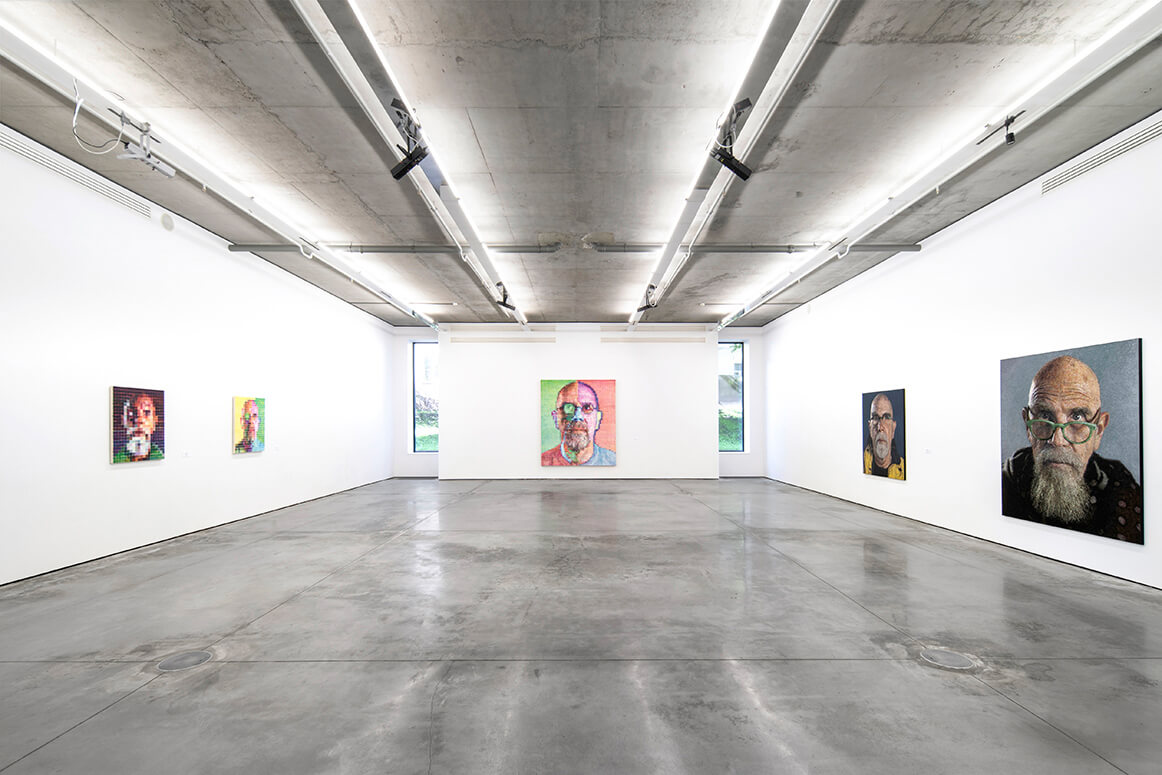Chuck Close
Chuck Close (1940, Monroe, WA, USA – 2021, Oceanside, NY, USA).
A legendary portrait painter and master of photorealism, Chuck Close is one of the most influential artists of his generation, renowned for his meticulous detail and innovative technique, which deeply impacted both American culture and the international art community.
With an artistic journey spanning over five decades, Close revolutionized the art scene, transforming the canons of academic portrait and experimenting in different forms of expression—from Polaroid photography to oil painting, mosaic-tilework, and tapestry. He created portraits from tonal grids of fingerprints, pointillist dots, brushstrokes, paper pulp, and countless other media.
In 1962, Close received his bachelor’s degree from the University of Washington. Immersed in abstraction, he radically changed his style after graduating from the Yale School of Art in 1964, beginning to work in photorealist techniques, creating large-format Polaroid images and transferring them to canvases. In 1967 he had his first solo show, and in 1971 the Los Angeles Museum of Art opened a major exhibition with a series of black and white portraits.
One of the first artists to use the camera in the late 1970s to make photographs as both the basis for painted portraits and as works themselves, Close created his own iconic tool by putting a grid on the photograph and then transferring a proportional grid to the large-scale canvases. Close’s signature method can be considered as follows: a subject is photographed; the photographic image is transferred onto a large oil painting on canvas via a systematic, grid-based rubric. As the painting progresses, a series of colors are concentrically inserted into the cell, creating combinations that alter the way we perceive the overall color. “Optical blending” is the phenomenon by which the human eye merges neighboring colors into a single hue. A viewer’s encounter with any work by Close hinges on this process, for the eye works first on a micro level to combine the colors in each cell into a single bit of color information, and then on a macro level, to add up the mosaic of individual bits, as the abstraction of the grid coalesces into an image of a human face.
“A face is a road map of someone’s life. Without any need to amplify that or draw attention to it, there’s a great deal that’s communicated about who this person is and what their life experiences have been.”
In the age of the selfie, the art of portraiture, at first glance, seems to play the role of filtering the photographic reality. But for Close, the story goes much deeper: Art became a way to communicate his pain—both physical and emotional—as well as a tool to celebrate his victory against the circumstances that tried to stop him from living his dream. In addition to the partial paralysis that made him use a wheelchair since 1988, the artist had prosopagnosia (face blindness), which drove him to portraits in the first place. He wanted to commit images of friends and family to memory, immortalizing the people and faces that mattered most. With his photographic memory for two-dimensional objects, he changed the faces to two-dimensional portraits. In fact, he had flourished as an artist not in spite of his neurological conditions, but because of them.
Chuck Close received a National Medal of Arts and was appointed by President Obama to serve on his President’s Committee on the Arts and Humanities. He was a member of the American Academy of Arts and Letters and served on the boards of the most prestigious arts organizations.
His artwork has been featured in hundreds of exhibitions as well as private and permanent museum collections around the world, including Museum of Modern Art (MoMA) (New York, NY, USA), Tate Britain (London, UK), Metropolitan Museum of Art (New York, NY, USA), Centre Pompidou (Paris, France), National Portrait Gallery (London, UK), Hiroshima City Museum of Contemporary Art (Hiroshima, Japan), Suermondt-Ludwig-Museum (Aachen, Germany) and many others.





